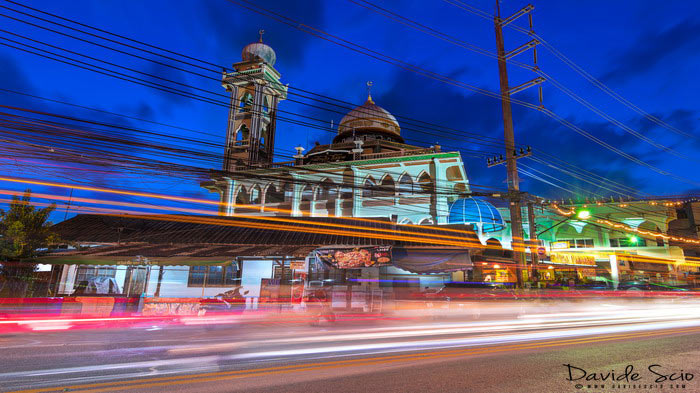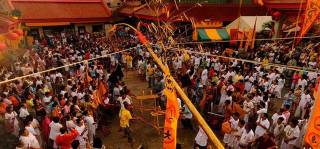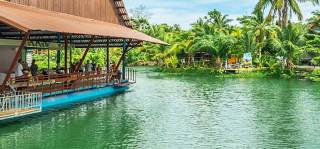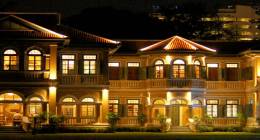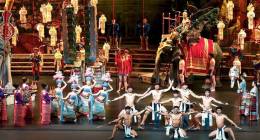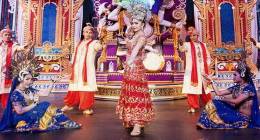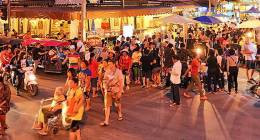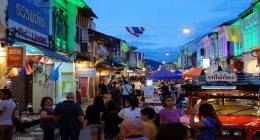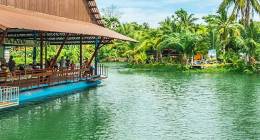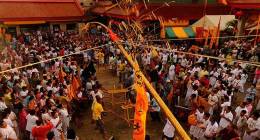Phuket Town
Phuket Town
Phuket Town is the capital and the largest city in Phuket Province. In 2007, the city had a population of 75,573 inhabitants. It is the economic hub of the island and houses the two bus terminals of Phuket as well as the Rassada Pier, the island's main jetty. Situated about 30 km from the International Airport, the city overlooks a large well-sheltered bay on southwest coast of island. Phuket is one of the oldest cities in Southern Thailand and boasts a rich and colourful history. According to some historians, colonists from India founded it in the 1st century B.C., when the island and whole Malaya Peninsula was part of the Shivite Empire. Throughout the centuries, there have been many external influences on Phuket Town, both eastern and western. In the 14th century, the town was important port on the west of the Malay Peninsula where trading vessels made regular stops for supplies and provisions. In the 16th century, Phuket also had Portuguese merchants and residents, who introduced chilli pepper and built homes and businesses in the Portuguese architectural style, which can still be seen in Phuket Town today. In the 17th century, Dutch, English and French competed for the opportunity to trade with Phuket Island, when tin extraction was the main economic source of the island, at that time known as "Junk Ceylon". Because of the growing importance of tin, during the beginning of the 19th century, many Chinese laborers began to flock to Phuket, whose strong influence can be still seen in the region. Most Chinese arrived from Penang, Malaysia, and built extravagant homes in the Sino-Portuguese architectural style, mainly in and around Phuket Town, which became the main port on the island. The old buildings in the town indicate its former prosperity and history. The particular architectural style, called "Sino-Portuguese", is a mix of European and Chinese style. Its main feature is the single or two-storey building with a narrow front but compensated by a considerable depth. Tiles, doors, perforated windows and other details are all influenced by Chinese and European styles mixed together. Most Phuket Town's history and heritage can be found in the Chinatown area on the northwestern side of the city around the renovated Thanon Thalang. Other streets with similar edifices, constitute what might be called "Old Phuket", they are Phang-nga, Yaowarat, Thalang, and Thanon Krabi. Ultimately, although most of Phuket Town is just an ordinary provincial Thai town, the historical Sino-Portuguese district of city is worth a visit, perhaps on the weekend when the Phuket Walking Street market take place here. Also known as Lard Yai, meaning ‘big market’ in southern Thai dialect, it is hosted every Sundays in Thanon Thalang from 16:00 till 22:00 and is a cosmopolitan mix of Chinese, Thai Muslim and Indian shops. Shopping seems to be the main reason for visitors to come to Phuket Town. In addition to Walking Street market, in the town there is a plenty of shops, several department stores, a good choice of malls and other daily or weekly local markets like the Phuket Weekend Market, which covering an area of 30,000 sqm is Phuket Island's largest market. It takes place every Saturdays and Sundays along the Chao Fa West Road on the outskirts of town. Open from 16.00 to 22.00, this market is a small version of world-famous Chatuchak Market in Bangkok and offers in addition to endless shopping opportunities a great choice of Thai street food. Located at the intersection of Bypass and Wichitsongkram roads in a large four-storey building, Central Festival Phuket is the second largest shopping mall in Phuket after Jungceylon in Patong Beach. It houses over 120 stores selling fashion and accessories, handicrafts, cosmetics and perfumes, photography and optics, books, jewellery as well as about 50 restaurants and food outlets, and an SFX Coliseum movie theatre on top floor. More





